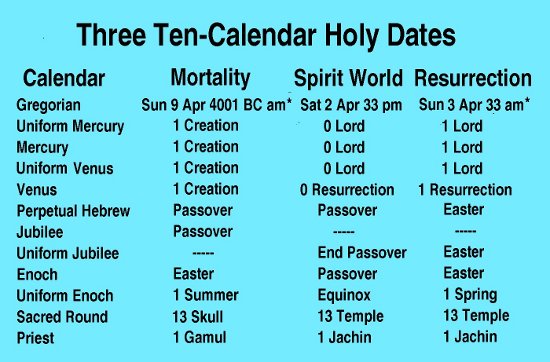
by John P. Pratt
2 Sep 2014, 1 Creation (V), 1 Light (SR)
©2014 by John P. Pratt. All rights Reserved.
| 1. Symbolism on Important Dates |
| 1.1 Adam's Mortality |
| 1.2 Christ's Resurrection |
| 1.3 Abraham & Sarah |
| 1.4 Fall of Adam |
| 2. Lesser Events |
| 2.1 Twelve Spies |
| 2.2 Death Prophecy |
| 2.3 Samuel H. Smith |
| 3. Invalid Dates |
| 4. Conclusion |
| Notes |
The Uniform Mercury Calendar (UM) was just introduced in a separate article.[1] As it was researched, it became clear that when the Uniform Venus Calendar (UV) was discovered,[2] an error had been made in correlating it to our Gregorian Calendar. The purpose of this article is to discuss the impact of the new correlation, which necessarily changes the UV dates of all events discussed. Overall, the new dates provide an even stronger witness of Christ and many key events of religious history. The new UV dates have been entered into the Religious Chronology page.
One of the most important results is that the symbolism of key religious dates is extremely important. There are 45 possible correlation points for the Uniform Venus Calendar. About half of those were considered in great detail before choosing one as best.
The mistake made was simply to choose the one that aligned the most holy days on key religious events of history. Any special symbolic meanings of the holy days was not given the extra weight it deserved. For example, being born on the day 1 Birth is 18 times more significant that just being born on any of the 18 holy days.
Also the importance of the event itself should be considered. The importance of the Resurrection of Christ far outweighs the importance of the re-dedication of the Jewish temple at the time of the Maccabees.
One of the most important dates in history was the Beginning of Mortality, from which point Biblical time is measured. The new correlation was discovered when it was noticed that the Mercury, Uniform Mercury, and Venus calendars all began (on 1 Creation) on that day. After careful checking of all dates, the Uniform Venus was also changed to being on that day because it was found that the witnesses of that calendar were improved, as discussed in this article.
In the recent article which summarized how several of the events in Christ's life were holy on eight days, it was noted that the only other such eight-holy-day date was that of the Beginning of Mortality.[3] But with the discovery of the Uniform Mercury Calendar and the new correlation of the Uniform Venus Calendar being such that Sun 9 Apr 4001 BC am* falls on 1 Creation, now that date is holy on ten of the eleven sacred calendars. The asterisk in the date means before 6 a.m.
 |
The only day in Table 1 which appears random is 1 Gamul on the Priest Calendar, but that is probably because its symbolism is not understood at present. The day "Jachin" at the Resurrection means "Upright" and refers to standing upright at the Resurrection. Note also that the Jubilee and Uniform Jubilee Calendars act as a team to provide three matching dates, similar to the Enoch and Hebrew Calendars. The odds against so many meaningful holy days happening by chance are phenomenal. But it didn't happen by chance. In fact, the UV correlation was just chosen precisely to have 1 Creation coincide with that date. But remember that when that one choice is made to align one date on a uniform calendar, then all other dates are totally determined. That includes the date of the Resurrection.
The scriptures talk much about how Adam and Jesus Christ are the two most important men in history. Adam is the father of the entire human race on earth. He also introduced death into the world. Jesus overcame death through the resurrection. The apostle Paul summarized it well: "For as in Adam all die, even so in Christ shall all be made alive" (1 Cor. 15:22). The two most important dates in history are arguably the date of the Beginning of Mortality and of the Resurrection.
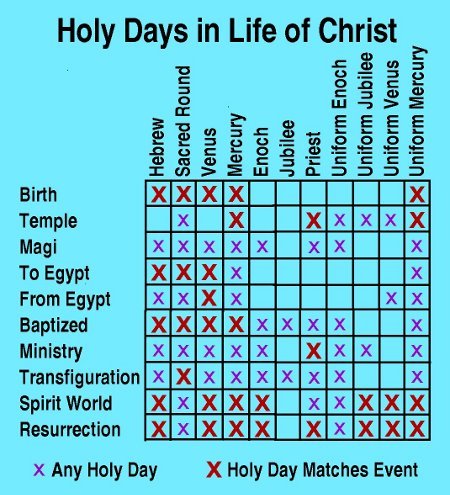 |
Table 2 lists ten holy events in the life of Jesus Christ. This table is nearly identical to the one in the recent article about ten sacred calendars testifying of Christ. That former table can be seen by clicking on this new table. Toggling between the two tables shows that the main difference is in the last two columns. The UV column is totally different because the correlation date has been changed, so every date is changed accordingly. Also, a UM column has been added.
It is not surprising that every Uniform Mercury date is holy because they are all aligned with the Sacred Round and Mercury Calendars. What is more important is the large red X's which indicate that the holy date is not random, but has symbolic meaning.
Looking at the Uniform Venus column, it is seen that the number of holy days has jumped from two to four. But most importantly, the date of the Resurrection is now 1 Lord, matching the Mercury and Uniform Mercury calendars.
In former articles, proposed birth dates for Isaac and Rebekah are given, as well as for Jacob and Leah and Rachel. Much fuss was made about calendar links between their birth dates, and most of the important links were on the Venus calendar. But what about Abraham and Sarah?
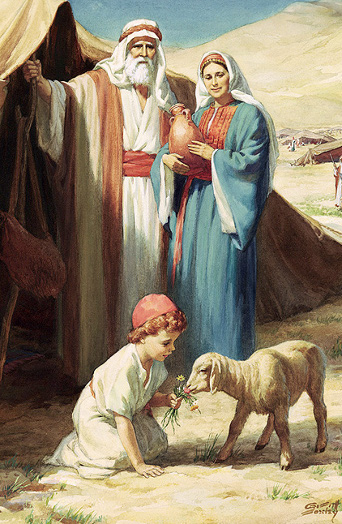 |
But Sarah has been left out of the picture entirely. There have been two dates which both have been candidates for her birth, but neither one was tied to either Abraham nor her son Isaac, so nothing has been published yet proposing a date for Sarah's birth.
Now all of that has changed. Both Abraham's birth date and one of the two candidates for Sarah fall on the very day 1 Birth on the Uniform Venus Calendar. That is not just any holy day, but the very one representing birth. There is only a 1 in 45 chance of that happening for a known date on the new UV calendar. That is, the date has been published for years so the UV calendar was not a factor in proposing it. But for one of the proposed dates for Sarah to also fall on the same day on that calendar is on 2 in 45, so that chance of both is only 2/(45 * 45) or about 1 in 1,000. That is a strong probability that it is not a chance correlation at all, but that their birth dates were planned ahead of time. That is a stronger calender link than exists between their offspring and their wives.
The proposed date for the birth of Sarah is Sat 16 May 2042 BC after sunset. That day was the Feast of Firstfruits on the Perpetual Hebrew Calendar (H), 1 Reed on the Sacred Round (SR), Easter Sunday on the Uniform Enoch Calendar (UE), 1 Quickening on the Mercury Calendar (M), and 1 Harim on the Priest Calendar (P). But now it can be added that it was 1 Birth (UV) and 1 Fulness (UM). That means it was holy on seven sacred calendars.
And as another extremely strong witness of family calendar links, the birth date of Terah, Abraham's father, has been in my database for a long time, but never seemed worthy of publishing, as he is not a strong patriarchal figure. That date is Tue 15 Apr 2122 BC pm*, which was the last day of Passover (H), 1 Temple (SR), 1 Resurrection (M) and 1 Fulness (UM). The main reason for it having been chosen was that it was the same day on the Sacred Round as Abraham's birth, which is the very day representing birth on that calendar. There is almost always a tie between patriarchal parents and at least one of their children.
But now a new link appears which greatly strengthens the case for his birth date as well as Abraham's and Sarah's. The proposed birth date for Terah is also 1 Birth (UV), the same as for both Abraham and Sarah. Remember that Terah is not only Abraham's father, but also Sarah's grandfather.[4] So that truly shows the family calendar alignments in a powerful manner, because both the days 1 Temple and 1 Birth are the only days on those calendars representing birth.
Just calculating the odds of Terah's proposed birth date (which was already known) just happening to also fall on 1 Birth adds another factor of 1/45, so now the odds of that being a chance occurrence are about 1/45,000.
Thus, just this one new date of Sarah's birth adds a very powerful witness that the new UV correlation is correct.
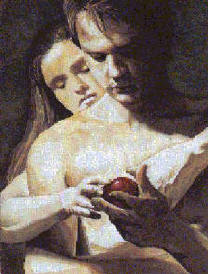 |
Moreover, the date of the Beginning of Mortality is still a holy day, now being 1 Creation (UV) as discussed above. So the new correlation yields two key events of religious history being on meaningful holy days, rather than just one.
Several other new dates showed up when the new correlation to the UV Calendar was adopted. Some which are simply mentioned here are the following. 1) The End of the Exile, at the Feast of Tabernacles during the reign of Cyrus, fell on both 1 Creation (V) and 1 Creation (UV). That seems very symbolic because it was a time of new beginning. 2) The martyrdom of John Huss, a known date from history, fell on 0 Creation (UV), bringing the total to seven simultaneous holy days. 3) The date of the three witnesses of the Book of Mormon fell on 1 Prime (UV), a holy day signifying rebirth. None of those events had fallen on holy days using the former UV correlation. Now consider three other significant dates.
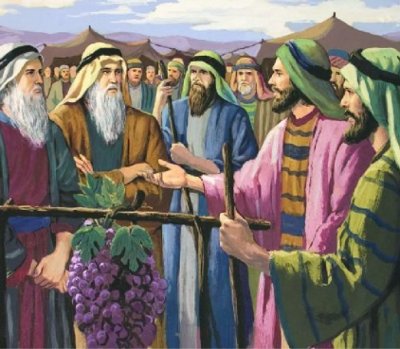 |
Using the former correlation, the day of their return fell on a UV holy day, being 1 Fulness. But the day of their departure was not on any significant day at all. The day 1 Fulness had no apparent symbolism, and it looked like a random coincidence. If it were meaningful, one would expect that both the beginning and end dates would be a pair of symbolic holy days. Even though the two dates were holy on multiple calendars, there was no obvious "40-day" symbolism.
Using the new correlation, the day on which they left was 1 Creation (UV). That is a perfect starting day because it is the starting day of the Venus Cycle. And the day on which they returned was 1 Quickening. That is also significant because the length of the Creation phase is 39 days, so 1 Quickening falls on the 40th day. That is the only Venus phase with a length of 39 days, so it is the only place where both beginning and ending days would be holy, and they fall at the beginning of the cycle. That is a perfect match, whereas the former was random. That is a witness that the new correlation is correct because both beginning and ending dates had already been proposed. They were not chosen because they fit this pattern, so they may be counted as a witness.
There is a database of 416 religious events and their proposed dates used in my work, used to calculate every date on every calendar for comparison. Only one of those dates fell on either 0 Death or 1 Death (UV) using the new correlation. One would expect a few (about 6) just from random chance. And that one date was of an obscure passage in the Book of Ezekiel which was only included in the database because the precise day of the event had been recorded. Of all Bible authors, Ezekiel records more precise dates than any other.
One night Ezekiel was struck dumb, and the next morning a runner came announcing that Jerusalem had been smitten. Ezekiel had already been taken captive to Babylon, and it took time for that news to arrive. His tongue was then loosed and he prophesied death in three ways to the wicked who would inhabit the wasted land of Israel: death by the sword, by being devoured by wild beasts, and by plague.
Ezekiel states that the day of his prophecy was 5 Tebeth (the tenth month) of the twelfth year of the Captivity (Ezek. 33:21). That day was Tue 2 Jan 585 BC. It was the day 0 Death (UV), and seems very appropriate for a day 0 Death. It was also the day 10 Winter on the Enoch Calendar, which corresponds to the day on the Hebrew when Nebuchadnezzar first began the siege on Jerusalem. So the date is a classic one, even if the only date representing events typical of 0 Death. With each new date discovered the randomness of the universe seems to decrease.
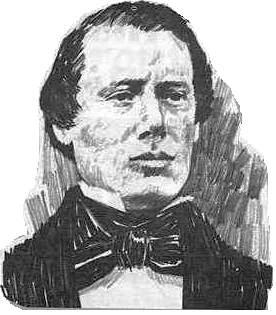 |
Samuel Smith was born on Sun 13 Mar 1808. That day was impressive enough that it was already on my list of important dates, even though nothing has been published about it yet. The day was the feast of Esther (H), 1 Rabbit (SR) and 1 Spring (UE) and holy on the Mercury and Priest calendars as well.
But now something much more impressive shows up. That day was also 1 Birth (UV). That is the one day representing birth on that calendar, and is the same as Abraham's proposed birth date. That is very unusual and worthy of report in this article.
What about the death date of Samuel? His mother Lucy Mack Smith gives the date of his death as 30 Jul 1844, caused by complications from having been chased by some of the mob who murdered his brothers Joseph and Hyrum a month earlier. Checking that date on sacred calendars shows nothing special. But just two days prior, Sun 28 Jul 1844 a.m. was a date as impressive as his birth date. That day was 1 Death (V), and also 1 Jaguar (SR), 1 Autumn (UE), and holy on the Mercury and Priest calendars also.
Sacred Calendar research has shown that very often birth and death dates form matching pairs, which testify that they were not just random occurrences. If the death date of Samuel had not been known, then this article would have proposed the day 28 Jul, principally because of the matching dates of being born on 1 Birth (UV) and dying on 1 Death (V). Moreover, the 1 Autumn (UE) is the counterpart of 1 Spring (UE) at his birth. And both were holy on the Mercury and Priest calendars as well. That's a lot of matching symbolism.
The two Venus dates are so rare, and the death date so close to what is recorded, that it might be worth checking on Samuel's death date from other original sources. Is it possible that he died on the 28th and was buried on the 30th? It was a time of great stress and grief and it seems possible that a mistake might have been made about his death date.
This brings up the question of whether this sacred calendar research is an art or a science. There is certainly science in calculating the positions of the planets and mathematically fitting a calendar to the known positions. But the predicting of birth and death dates has been mostly an art, determined by looking at patterns from known examples. The true power of science is in predicting the results of future experiments, based on past observations. Therefore, if ancient dates, which cannot be verified otherwise, are proposed by reference to the sacred calendars, then it seems that some attempt should be made to check on predictions on modern dates which can be verified. Therefore, it is here suggested that research into the death date of Samuel H. Smith might show that indeed he died on the morning of Sun 28 Jul 1844.
Several of the events which fell on holy dates (UV) no longer do so using the new correlation value. Let's look at some of those which are no longer valid.
Using any correlation date, the date of the first Hanukkah at the re-dedication of the Jewish temple falls on the same date as the birth of the Savior (UV). Using the former correlation that date was the holy day 1 Quickening (UV). With the new correlation, neither day is a holy day. It is not clear that there is any symbolic connection between the two events. If there is, then happening on the same day might be significant even if not on a holy day.
Again, using any correlation date, the death of Adam and the birth of the LDS Church occurred on the same day. Using the former correlation, that day was 0 Resurrection which seemed meaningful and symbolic for both events. It was one of the reasons for selecting that correlation. But as important as those two events were, at this point they do not outweigh the reasons given above for accepting the new correlations.
Also lost are the holy days (UV) for the events of the Jewish Temple being burned in AD 70 on 0 Lord, the Book of Mormon coming forth on 1 Death (which now really appears to have been random), and the death of Abel and birth of Seth. Again, these losses do not outweigh the gains of the new correlation.
One point can also be made about the loss of random dates which is actually a step forward. Consider the case of the twelve sons of Jacob. Jesus told a parable about a man having twelve sons and how they should be treated equally (D&C 38:26). In the case of the the twelve tribes, one salient feature when their birth dates were being discovered was that all were very close to being equally holy, with no obvious preference from birth. One would expect with the new UV calendar that about 2 of them would have holy day birth dates just from random chance. Using the former correlation indeed two of them did (Dan on 1 Quick and Naphtali on 1 Death). Using the new correlation, none of the birth dates is holy on the UV Calendar. So now they are all more equal again, and those two losses appear to indeed be a gain.
One of the big points in the original paper on the UV Calendar was that many women had birth dates on holy days using the original correlation. It turns out all of those birth dates are also holy using the new correlation except one: that of Naamah the wife of Noah. That birth date is still holy on many other calendars, so the date for the event still appears to be correct. And of course Sarah's birth date was gained so the tally is even in that area. Note the important difference that Sarah's date has two other witnesses that it is correct, being Abraham and Terah. While Naamah's date is most likely still correct, there was no second witness of the UV date.
The final loss is the theory that was presented about a pattern for the births of seven chief angels. In that paper, after a long discussion of pros and cons, it was concluded that the theory had serious weaknesses, which were listed, and that "time will tell." Now time has told, and the theory now appears false. Even though much space was devoted to the theory in that article because it looked promising, it is no great loss because the facts did not support it even with the former correlation date.
The newly discovered corrected correlation of the Uniform Venus Calendar is discussed in detail. It is concluded that meaningful symbolism on the most important religious dates outweighs the other considerations which led to choosing the first correlation date. Two of the most important events in history are the date of the Beginning of Mortality and the Resurrection of Christ, neither of which were holy days using the former correlation. The new correlation begins at Mortality and culminates at the Resurrection. New dates are discussed, such as the birth of Sarah which falls on 1 Birth (UV) as does her husband Abraham. This is an example of a meaningful holy day (1 Birth) for very important religious figures. Other new dates are discussed as well as those which were invalidated with the new correlation. Overall, it is concluded that the new correlation provides an even stronger witness of the scriptures and of Jesus Christ.